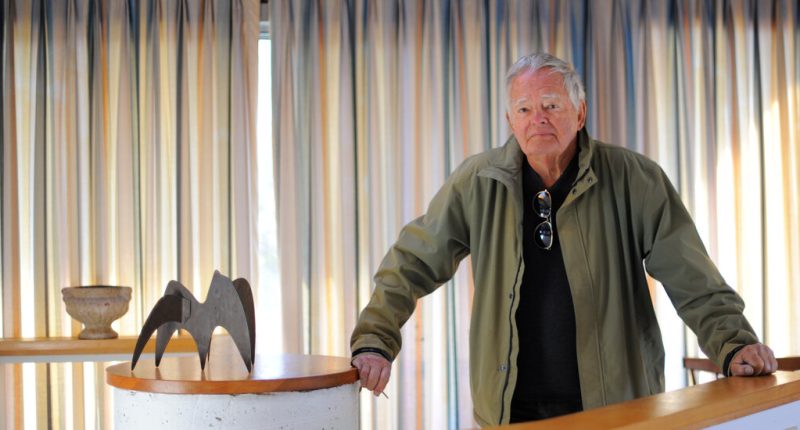
Paul Brodeur, whose deeply reported articles in The New Yorker brought national attention to subjects like the toxic hazards of asbestos and the destructive impact of chlorofluorocarbons on the ozone layer, died on Aug. 2 in Hyannis, Mass. He was 92.
His death, in a hospital, was caused by complications of pneumonia and hip replacement surgery, said his daughter, the novelist and memoirist Adrienne Brodeur.
Mr. Brodeur’s first long-form article for The New Yorker, “The Magic Mineral,” published in 1968, described at great length the history of asbestos, a heat-resistant fiber with a history of being used in thousands of products — including building and insulation materials, rugs, potholders, roofing, military helmets and gas masks — and its connection to cancer, particularly mesothelioma, among workers who had been exposed to it.
“There is not an automobile, airplane, train, ship, missile or engine of any sort that does not contain asbestos in some form or other, and it has found its way into literally every building, factory, home and farm across the land,” he wrote. “And, because its minuscule fibers are eminently respirable, asbestos has also found its way into the lungs of man, where, by remaining as indestructible as it does in nature, it can wreak terrible havoc.”
It was the sort of exposé that called to mind the groundbreaking work of Rachel Carson, whose book “Silent Spring,” about the devastating ecological impact of pesticides and insecticides like DDT, had been serialized in three parts in The New Yorker in 1962.
William Shawn, the editor of the magazine at the time, had encouraged Ms. Carson, and then Mr. Brodeur, to write about the environment. Mr. Brodeur continued to write about asbestos, most notably in two series over the next two decades.
The first, spread over five parts in 1973, examined the impact of asbestos on workers and the failure of federal agencies to keep companies from exposing employees to myriad health consequences. It won The New Yorker a National Magazine Award.
The second series, in 1985, was about lawsuits filed by victims against asbestos companies, including the Manville Corporation, the world’s largest producer, which filed for Chapter 11 bankruptcy protection in 1982.
“He wrote in such a way that people learned what asbestos was, where it was found and how people could be exposed to it,” Dr. Richard Lemen, a former assistant United States surgeon general, said in a phone interview. He added, “I think his reporting had a big impact on the industry; it took notice, and it had to clean up its act.”
At the beginning of the first series, Mr. Brodeur described a conversation he had with Clarence Holder, an assistant regional administrator of the Occupational Safety and Health Administration in Dallas, about the unsafe conditions at a recently shuttered asbestos insulation plant in Tyler, Texas, where dust was so thick that workers could not see across the building.
“I asked Holder if he knew that asbestos inhalation could raise not only pulmonary scarring but lung cancer, mesothelioma and other malignancies,” Mr. Brodeur wrote. “He replied that he had never heard of mesothelioma and that he doubted if there was any real proof that asbestos could cause cancer.”
The Environmental Protection Agency tried to ban the use of asbestos use in 1989. The effort was overturned by a federal court two years later, but the ruling retained prohibitions against new uses of asbestos. It is still used in the manufacture of household bleach, bulletproof vests, electrical insulation and automotive products.
Paul Adrian Brodeur Jr. was born on May 16, 1931, in Boston and grew up in nearby Arlington, Mass. His father, who fought as an artillery officer in the French Army during World War I, was an orthodontist and a sculptor of bronze bas-relief portraits. His mother, Sarah (Smith) Brodeur, was an actress who became a professor of early childhood education at Endicott College in Beverly, Mass.
After graduating from Phillips Academy in Andover, Mass., Mr. Brodeur attended Harvard, where he majored in English and graduated with a bachelor’s degree in 1953. He then served for two years as an Army counterintelligence agent in Europe.
He stayed in Paris for a year after his discharge and sold a short story, “The Sick Fox,” an allegory about the postwar mood in Germany, to The New Yorker in 1957. He turned it into his first novel, published in 1963.
After joining the magazine’s staff in 1958, Mr. Brodeur initially wrote Talk of the Town pieces, commentaries and short stories.
He had a reputation at The New Yorker as a tough, punctilious and pugnacious reporter.
“He’s a feisty individual,” Anthony Bailey, another staff writer, told The New York Observer (now known simply as Observer) in 2014. “He reminds me, in many ways, of the French writers of the 19th century — people like Zola, who got very worked up about justice.”
In addition to asbestos, Mr. Brodeur got worked up about hazards like aerosol sprays and air-conditioners that emitted chlorofluorocarbons, or CFCs, which has led to a breakdown in the ozone layer. In 1975, he was among the first to report, on the ozone layer’s depletion. In a second article, in 1986, he described the impacts of a hole in the ozone layer, including changes in crop yields, higher skin cancer rates and the killing of the larvae of seafood species, including shrimp and crab.
A. Karim Ahmed, a former research director of the Natural Resources Defense Council, said that Mr. Brodeur’s 1975 article influenced federal agencies like the Environmental Protection Agency and the Consumer Product Safety Commission as CFCs began to be phased out well before a 1987 international treaty, the Montreal Protocol, started to regulate the production and consumption of chemicals that damage the ozone layer.
“His article and our work helped give the U.S. a head start in phasing out CFCs over everyone else,” Dr. Ahmed said in a phone interview.
Mr. Brodeur also reported on the possible dangers of radiation from microwave ovens, computer terminals and electromagnetic power lines. But this reporting was not as widely accepted as his work on asbestos and CFCs.
In 1997, the National Academy of Sciences found little to no evidence of any risk from power-line radiation. Other studies have been far from conclusive. (Mr. Brodeur noted, however, that the World Health Organization classified microwave radiation from cellphones to be a possible carcinogen.)
And in 2019, the science journalist William J. Broad of The Times found that in his 1977 book, “The Zapping of America: Microwaves, Their Deadly Risk, and the Cover-Up,” Mr. Brodeur had relied on “suggestive but often ambiguous evidence to argue” that the growing use of the high frequencies of microwaves could endanger human health.
Like “The Zapping of America,” many of Mr. Brodeur’s nonfiction books grew out of his reporting for The New Yorker. Among them were “Outrageous Misconduct: The Asbestos Industry on Trial” (1985); “Currents of Death” (1989); and “The Great Power-Line Cover-Up: How the Utilities and the Government Are Trying to Hide the Cancer Hazard Posed by Electromagnetic Fields” (1993).
He also wrote another novel, “The Stunt Man” (1970), about a young Army deserter who becomes a stuntman for a tyrannical director. It was adapted into a film in 1980 starring Peter O’Toole as the director and Steve Railsback as the title character.
Mr. Brodeur published a memoir, “Secrets: A Writer in the Cold War,” in 1997.
In addition to his daughter, he is survived by his son, Stephen; three grandchildren; and his sister, Valjeanne Paxton. His marriages to Malabar Schleiter and Margaret Staats ended in divorce. He had separated from his third wife, Milane Christiansen, before her death in 2013. His brother, David, died in 2019. Another son, Alan, died in infancy.
Mr. Brodeur learned when he was in college that he had another brother, Adrian Paul Brodeur, from his father’s earlier marriage. He died in 1992. Paul and Adrian never met.
Mr. Brodeur left The New Yorker shortly after Tina Brown took over as editor in 1992.
His final article was, fittingly, a reminder of Rachel Carson’s legacy.
After citing the implications for breast cancer prevention found in a recent study that showed that women with the greatest exposure to DDT were four times more likely to develop breast cancer than women with the least exposure, he concluded:
“Rachel Carson lives.”
Source: | This article originally belongs to Nytimes.com






